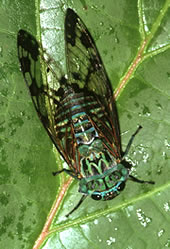Cicadas appear in their prime
Irregular emergence may foil insects' predators.
23 July 2001
ERICA KLARREICH
 | | Cicadas emerge after a prime time. | | © SPL |
|
|
Bob Dylan immortalized the rare appearance of periodic cicadas in his 1970 song Day of the Locusts. But he may not have realized that he was honouring a mathematical event as well as a biological one. Periodic
cicadas emerge from their underground homes to mate every 13 or 17
years. Both of these numbers are prime - they can only be divided by
one. Evolution could have selected for appearance in prime cycles, a
new model suggests1. The notion is
simple: cicadas with prime cycles coincide with their predators and
parasites less often. "The philosophy is that if cicadas have 12-year
cycles, all the predators with two, three, four, and six-year cycles
will eat them," says Mario Markus, a physicist at the Max-Planck
Institute for Molecular Physiology, who led the study. "If the cicadas
mutate to 13-year cycles, they will survive." Now a mathematical
model created by Markus' team shows that cicadas naturally evolve such
cycles. Cicadas were assigned a random fitness score on the basis of
cycle length and the frequency with which they encountered competitors.
Over time, cycle length evolved until the cicadas hit a prime number,
they found. The model assumes that in the past there were cicada
predators and parasites that became extinct though a lack of the
insects. "It's a bold assumption," says Markus. Evidence of such a
creature would give the model a boost. An ancient wasp is one
hypothetical parasite. The wasp couldn't lengthen its life cycle to
keep up, explains Christine Simon, who studies cicadas at the
University of Connecticut in Storrs, "so the periodical cicada outran
it in time". But the idea is highly speculative, as fossil records of
the wasp have never been found. Why cicadas evolved such long
cycles is also unexplained, says Simon. A long cycle seems to be a
disadvantage, as the population would grow more slowly than that of
competitors who reproduce more often. The idea that prime cycles
exist to evade predators has been around for a while, says Sir Robert
May, a zoologist at the University of Oxford, but no one could
understand how they evolved. "This new work is an interesting
contribution," he says. Markus' model has an unexpected spin-off:
it is a machine for generating prime numbers. Large primes are rare and
difficult to find, but starting with any cycle length, the evolutionary
model drives it towards one. Although the model is not as efficient as
some prime-locating methods, its biological source makes it unique,
says Markus. "This bridges the gap between biology and number theory,"
he says. | 
